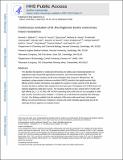| dc.contributor.author | Badran, Ahmed H. | en_US |
| dc.contributor.author | Guzov, Victor M. | en_US |
| dc.contributor.author | Huai, Qing | en_US |
| dc.contributor.author | Kemp, Melissa M. | en_US |
| dc.contributor.author | Vishwanath, Prashanth | en_US |
| dc.contributor.author | Kain, Wendy | en_US |
| dc.contributor.author | Nance, Autumn M. | en_US |
| dc.contributor.author | Evdokimov, Artem | en_US |
| dc.contributor.author | Moshiri, Farhad | en_US |
| dc.contributor.author | Turner, Keith H. | en_US |
| dc.contributor.author | Wang, Ping | en_US |
| dc.contributor.author | Malvar, Thomas | en_US |
| dc.contributor.author | Liu, David R. | en_US |
| dc.date.accessioned | 2016-11-18T20:48:11Z | |
| dc.date.issued | 2016 | en_US |
| dc.identifier.citation | Badran, A. H., V. M. Guzov, Q. Huai, M. M. Kemp, P. Vishwanath, W. Kain, A. M. Nance, et al. 2016. “Continuous evolution of B. thuringiensis toxins overcomes insect resistance.” Nature 533 (7601): 58-63. doi:10.1038/nature17938. http://dx.doi.org/10.1038/nature17938. | en |
| dc.identifier.issn | 0028-0836 | en |
| dc.identifier.uri | http://nrs.harvard.edu/urn-3:HUL.InstRepos:29408387 | |
| dc.description.abstract | The Bacillus thuringiensis δ-endotoxins (Bt toxins) are widely used insecticidal proteins in engineered crops that provide agricultural, economic, and environmental benefits. The development of insect resistance to Bt toxins endangers their long-term effectiveness. We developed a phage-assisted continuous evolution (PACE) selection that rapidly evolves high-affinity protein-protein interactions, and applied this system to evolve variants of the Bt toxin Cry1Ac that bind a cadherin-like receptor from the insect pest Trichoplusia ni (TnCAD) that is not natively targeted by wild-type Cry1Ac. The resulting evolved Cry1Ac variants bind TnCAD with high affinity (Kd = 11–41 nM), kill TnCAD-expressing insect cells that are not susceptible to wild-type Cry1Ac, and kill Cry1Ac-resistant T. ni insects up to 335-fold more potently than wild-type Cry1Ac. Our findings establish that the evolution of Bt toxins with novel insect cell receptor affinity can overcome Bt toxin resistance in insects and confer lethality approaching that of the wild-type Bt toxin against non-resistant insects. | en |
| dc.language.iso | en_US | en |
| dc.relation.isversionof | doi:10.1038/nature17938 | en |
| dc.relation.hasversion | http://www.ncbi.nlm.nih.gov/pmc/articles/PMC4865400/pdf/ | en |
| dash.license | LAA | en_US |
| dc.subject | protein evolution | en |
| dc.subject | PACE | en |
| dc.subject | bacterial 2-hybrid | en |
| dc.subject | Bacillus thuringiensis toxin | en |
| dc.subject | insect resistance | en |
| dc.subject | insecticide | en |
| dc.subject | plant biotechnology | en |
| dc.subject | agriculture | en |
| dc.title | Continuous evolution of B. thuringiensis toxins overcomes insect resistance | en |
| dc.type | Journal Article | en_US |
| dc.description.version | Version of Record | en |
| dc.relation.journal | Nature | en |
| dash.depositing.author | Badran, Ahmed H. | en_US |
| dc.date.available | 2016-11-18T20:48:11Z | |
| dc.identifier.doi | 10.1038/nature17938 | * |
| dash.authorsordered | false | |
| dash.contributor.affiliated | Badran, Ahmed | |
| dash.contributor.affiliated | Liu, David | |


